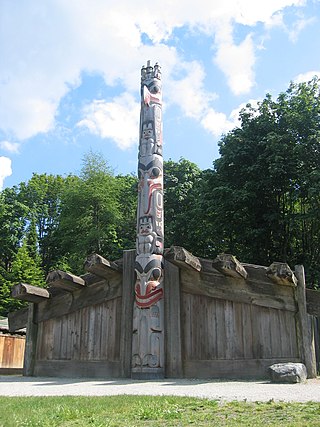Related Research Articles

A tipi or tepee is a conical lodge tent that is distinguished from other conical tents by the smoke flaps at the top of the structure, and historically made of animal hides or pelts or, in more recent generations, of canvas stretched on a framework of wooden poles. The loanword came into English usage from the Dakota and Lakota languages.
Lodge is originally a term for a relatively small building, often associated with a larger one.

Meg Tilly is an American-Canadian actress and writer.

A longhouse or long house is a type of long, proportionately narrow, single-room building for communal dwelling. It has been built in various parts of the world including Asia, Europe, and North America.

A wigwam, wickiup, wetu (Wampanoag), or wiigiwaam is a semi-permanent domed dwelling formerly used by certain Native American tribes and First Nations people and still used for ceremonial events. The term wickiup is generally used to refer to these kinds of dwellings in the Southwestern United States and Western United States and Northwest Alberta, Canada, while wigwam is usually applied to these structures in the Northeastern United States as well as Ontario and Quebec in central Canada. The names can refer to many distinct types of Indigenous structures regardless of location or cultural group. The wigwam is not to be confused with the Native Plains tipi, which has a different construction, structure, and use.

Longhouses were a style of residential dwelling built by Native American and First Nations peoples in various parts of North America. Sometimes separate longhouses were built for community meetings.

William Kurelek, was a Canadian artist and writer. His work was influenced by his childhood on the prairies, his Ukrainian-Canadian roots, his struggles with mental illness, and his conversion to Roman Catholicism.

A hut is a small dwelling, which may be constructed of various local materials. Huts are a type of vernacular architecture because they are built of readily available materials such as wood, snow, ice, stone, grass, palm leaves, branches, clay, hides, fabric, or mud using techniques passed down through the generations.

A hogan is the primary, traditional dwelling of the Navajo people. Other traditional structures include the summer shelter, the underground home, and the sweat house. A hogan can be round, cone-shaped, multi-sided, or square; with or without internal posts; with walls and roof of timber, packed earth, and stone in varying amounts, and a bark roof for a summer house. The door traditionally faced east to welcome the rising sun, believed to bring good fortune.

A smoke hole is a hole in a roof for the smoke from a fire to vent. Before the invention of the smoke hood or chimney, many dwellings had smoke holes to allow the smoke from the hearth to escape. Pre-modern English homes with unglazed windows or thatch roofs required no special vent for smoke. These structures typically had only one story for living spaces, and inhabitants made do with a band of relatively clear air near the ground.

Marie-Louise Gay is a Canadian children's writer and illustrator. She has received numerous awards for her written and illustrated works in both French and English, including the 2005 Vicky Metcalf Award, multiple Governor General's Awards, and multiple Janet Savage Blachford Prizes, among others.
Squamish culture is the customs, arts, music, lifestyle, food, painting and sculpture, moral systems and social institutions of the Squamish indigenous people, located in the southwestern part of British Columbia, Canada. They refer to themselves as Sḵwx̱wú7mesh. They are a part of the Coast Salish cultural group. Their culture and social life is based on the abundant natural resource of the Pacific Northwest coast, rich in cedar trees, salmon, and other resources. They have complex kinship ties that connect their social life and cultural events to different families and neighboring nations.
Richard Scrimger is a Canadian writer who has published fourteen books since 1996. He is best known for his children's literature, but has also written three books for adults: Crosstown, Still Life With Children and Mystical Rose. A winner of the Mr. Christie Award and recipient of dozens of award nominations, Scrimger is a favourite with many children and adults. All of his novels except The Boy From Earth and Still Life With Children have been short-listed for readers' choice awards. Several of his books have been named to Best-of, or Top-ten, or Notable lists by various libraries and publications, including Young Adult Library Services Association, Chicago Public Library, American Library Association, Time Out New York Kids, The Globe and Mail, Quill & Quire. His books have been translated into Dutch, French, German, Thai, Korean, Portuguese, Slovenian, Italian, and Polish.
Tundra Books is the oldest children's book publisher in Canada.
The Christie Harris Illustrated Children's Literature Prize is awarded annually as the BC Book Prize for Canadian authors and illustrator of picture books, picture story books, and illustrated non-fiction books. The prize is shared by the author and the illustrator, who must be a resident of British Columbia or Yukon. It was announced in 2002 and first awarded in 2003. A handful of finalists are also selected for another award: participation in the expenses-paid BC Book Prizes on Tour, a week-long tour across the province to present their books at schools and libraries each April.

Qarmaq is an Inuktitut term for a type of inter-seasonal, single-room family dwelling used by Inuit. To the Central Inuit of Northern Canada, it refers to a hybrid of a tent and igloo, or tent and sod house. Depending on the season, the lower portion was constructed of snow blocks or stone, while the upper portion used skins or canvas. To the Kalaallit of Greenland, qarmaq refers to the dwelling's wall. Qarmaq were built in the transitional seasons of fall and spring with a circular wall of stone, sod, or blocks of snow, a framework usually made from animal bones, which were covered with a skin.
Leo Yerxa is a Canadian visual artist, medallist, and writer. As an illustrator of children's picture books he won the Governor General's Award in 2006. He lived in Ottawa, Ontario, then. He died on September 1, 2017.

Linda Holeman is a Canadian author of fiction.
Joanne Fitzgerald was a Canadian artist, illustrator and writer. Twice-shortlisted for the Canadian Governor General's Award for Children's Illustration, her book Dr. Kiss Says Yes won the award in 1991.
Grace A. Paull (1898–1990) was an American artist, illustrator, and author. She designed greeting cards, illustrated children's books, and painted people, landscapes and flowers.
References
- 1 2 3 4 5 6 7 Hedblad, Alan, ed. (1998). Something About The Author . Vol. 96. Gale Research. pp. 206-208. ISBN 0-7876-1149-2 . Retrieved 8 May 2020.
- ↑ "Houses of bark : tipi, wigwam and longhouse : native dwellings : woodland Indians / Bonnie Shemie". Smithsonian Institution.
- 1 2 Jurenka, Nancy Allen (May 11, 2001). Hobbies Through Children's Books and Activities. Libraries Unlimited. ISBN 9781563087738 – via Google Books.
- ↑ "Children's book week: Unique homes focus of talk". Times Colonist. 1996-11-07. p. 28. Retrieved 2020-05-10.
- ↑ Peterson, Andie (October 19, 2007). A Second Look: Native Americans in Children's Books. AuthorHouse. ISBN 9781452087870 – via Google Books.
- ↑ Skogan, Joan (November 1989). "Houses of Snow, Skin and Bones - Native Dwellings: The Far North". CM: A Reviewing Journal of Canadian Materials for Young People. 17 (6). Canadian Library Association. Retrieved 8 May 2020.
- ↑ Wells, Joan (1991-01-12). "Book takes informative look at architecture of natives". The Ottawa Citizen. p. 88. Retrieved 2020-05-10.
- ↑ Fry, Patricia (March 1993). "Houses of Wood: Native Dwellings of the Northwest Coast". CM: A Reviewing Journal of Canadian Materials for Young People. 21 (2). Canadian Library Association. Retrieved 9 May 2020.
- ↑ Shemie, Bonnie (March 31, 1995). Mounds of earth and shell: native sites : the southeast. Tundra Books. ISBN 9780887763526 – via Google Books.
- ↑ Boer, Fred (December 1996). "Houses of China". Quill & Quire .
- ↑ Bergwerff, Julie (March 1997). "Children's Books". Books in Canada: The Canadian Review of Books. Retrieved 9 May 2020.
- ↑ Lawlor, Patty (March 2001). "Building Canada". Quill and Quire.
- ↑ Shemie, Bonnie (January 1, 2001). Building Canada. Tundra. ISBN 9780887765049 – via Google Books.
- ↑ Hoyte, Carol-Ann (Fall 2002). "Building America". Montreal Review of Books. AELAQ (Association of English-language Publishers of Quebec). Retrieved 8 May 2020.